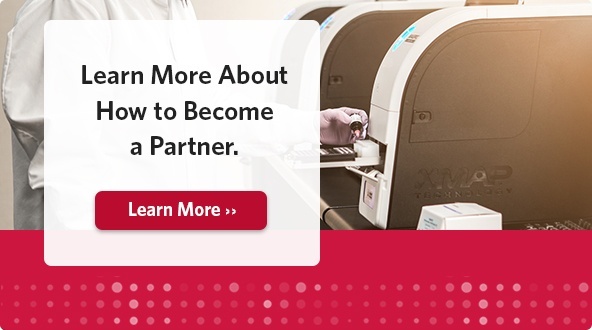Custom assay development

At Radix, scientists design and manufacture Luminex assays so their customers can focus on what they’re really interested in: the results.
The company is one of our Licensed Technologies Partners, a group that includes a wide range of markets, organization types, and locations. All of the Licensed Technologies Partners conduct work that is powered by Luminex’s versatile xMAP® Technology, which has supported the launch of thousands of multiplexed immunoassays as the basis for commercially available kits and testing services.

Texas-based Radix is a small company that works closely with customers to streamline the design, development, and implementation of xMAP-based multiplex assays. We spoke with Cari McDonald, a research scientist at Radix, to learn more.
How did Radix get started?
We were founded back in 2001 by some of the same people who founded Luminex. Our CSO, Kerry Oliver, was one of the first Luminex employees. While he was there, he saw a need for custom assay development. At the time, Luminex was focusing on its platform and beads rather than on content. Kerry and some of the Luminex founders started Radix to fill that niche and to help customers who wanted to run assays when no kits were available to meet their needs.
What does Radix do today, and what services do you offer?
Radix is a custom assay development company. Luminex users come to Radix and outline their needs, have us develop that assay, qualify it, manufacture it for them, and potentially even run their samples for them. We develop and manufacture assays for biopharma as well as environmental testing and infectious disease applications.
How does Radix differentiate itself from other assay developers?
We really work with customers to help them think about things they may not have considered, such as downstream workflow or automation. How they want to use the kit later could influence how we manufacture the kit and provide it to them. Someone running the assays at high capacity will probably do better receiving bulk kits, with everything they need each day in a single bottle, rather than opening 10 single-use vials every day. That seems to be what people really like about us — our thoroughness and ability to pinpoint things they may not have even thought about.
Can you share an example of how that plays out?
Recently we had a big pharma client that wanted a multiplex Luminex assay developed for them. We worked closely with them as we developed the assay, making sure it would work for their sample type. Then we visited their facility. We asked questions like ‘How are you going to implement this?’ and ‘How many assays are you going to run each day?’ and ‘Where’s the lab space you’re going to run it?’ We identified the bottlenecks that would occur in the pipeline and got them automated washers and automated pipette handlers that would work for their flow and throughput to make sure they could reach the target capacity. We also convinced them to upgrade to the FLEXMAP 3D® rather than the Luminex® 200™ so they could get the throughput they were looking for in the timeframe they needed. These were things our customer hadn’t even thought of, and we ended up being a guiding force in their whole project. Our focus is to make sure our customers are as successful as they can be, and that goes well beyond the actual assay.
Why do users need help with assay development?
For an easily developed assay, most people can do that on their own. But when you get into making an assay more sensitive or overcoming a difficult matrix, it can be more challenging. The number one thing we offer is our expertise. We know the antibody companies that we find to have the best products, and we know how to screen those antibodies and overcome matrix effects.
What is it about xMAP Technology that has kept Radix working with it all this time?
We love the platform. It’s a powerful platform and there’s really nothing like it on the market. It continues to provide us new insight every day and we think of new ways to use it every day. ELISA is the gold standard but it’s really limited in what you can do with it. You look at Luminex and its ability to multiplex and its quick assay timeframes; it continues to perform over and over again.
Aside from the technology, are there any other benefits you’ve had as a Luminex partner?
The Luminex company is easy to work with. We have close relationships with individual employees there. It may be a large company but it still feels like a tight-knit family that will help you. They are very supportive of their customers.
Are you interested in developing, manufacturing, and commercializing a multiplexed assay on a platform that is efficient, flexible, and widely-adopted? Contact Luminex Business Development at http://info.luminexcorp.com/en-us/become-a-partner.
Resources
- Getting Started with xMAP® Technology [Video]
- Browse 1,200+ Partner Kits with xMAP® Kit Finder [Online]
- xMAP® Cookbook to Design Your Own Assays [Download]
- View the latest xMAP® Insights Newsletter [Online & Download]
